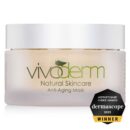Natural Facial Skin Care for Acne
Almost everyone has suffered from an acne breakout (or many more) in their lifetime. Acne occurs when the oil (or sebaceous) glands under hair follicles, usually on your face, neck, chest, or back, get plugged up, inflamed, or infected. Frequently the glands simply secrete too much of a thick waxy lubricant called sebum that keeps your skin healthy. This blocks the pores and creates a perfect breeding ground for bacteria. Follicles then get red and inflamed.
Hormone imbalances can play a role as well. Sebum increases with the overproduction of testosterone and other androgens in teenage boys, for instance, or with women;s hormonal fluctuations, such as those associated with the menstrual cycle, pregnancy, and menopause. In mild cases of acne, whiteheads and blackheads appear, and maybe some raised red blemishes. In more severe cases, pus-filled cysts and deep nodules form around the inflamed follicles, causing unsightly bumps, tenderness, and often pain.
Organic Skin Treatments for Acne
A couple of herbal products are useful for drying up acne. Topically applied tea tree oil is a natural alternative to benzoyl peroxide. Tea tree oil is fungicidal, antiseptic, expectorant, anti-infectious, anti-inflammatory, parasiticide, and antiviral. Wipe on a 10% to 15% strength solution twice a day.
The herb chamomile also has long been used for easing skin inflammations. Make a strong chamomile tea, and wipe the cooled liquid over your face each morning. This effective daily rinse tones and cleanses.
The holistic understanding of acne is generally the result of hormonal imbalance or toxicity of the bowel or blood. Use cleansing herbs like burdock root, yellow dock root, or echinacea root to help cleanse your blood and remove toxic waste products from your liver. Use bowel-cleansing herbs like yellow dock root and psyllium seed for a week, and repeat once a month for several months, especially if you have trouble with boils, acne, and other skin problems. Take evening primrose capsules. And apply tea tree oil solution externally.
Here’s a helpful tea recipe:
1 tablespoon Oregon grape root
1 tablespoon yellow dock root
1 tablespoon burdock root
1 tablespoon red clover flowers
2 cups water
Put all herbs in water and simmer 30 minutes. Drink one cup of the tea, 2 to 3 times daily.
During a breakout, eat mainly fresh fruits and vegetables, and add a six-ounce glass of cleansing vegetable juice with equal parts of cucumber, carrot, and celery, with a little parsley. Identify and drastically reduce all forms of refined sugar and fried foods in your diet – this includes honey.
Alternate hot and cold compresses over pimples once or twice a day to open the pores, cleanse them, and increase circulation to remove wastes.
Sometimes the skin will show reactions to external factors, such as bacteria, that have led to internal processes, which reflect on the skin instead of manifesting internally. While symptoms on the skin should be attended to, the real problem lies in the weakened defense system, which should be toned and strengthened so that the body will rid itself of infection.
The general guidelines for the treatment of infections also hold true for acne. And if antibiotics have been used recently, at least 1 g of vitamin C should be taken daily.









